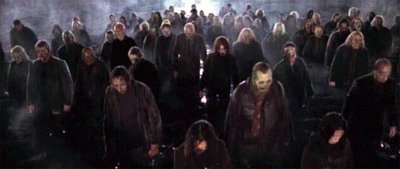
Land of the Dead (2005)
Director: George A. Romero
During the 1950s, an explosion of cheap B-horror movies flooded theatres that made a fairly sharp break from the horror conventions that preceded them and started laying the groundwork for new kinds of escapist thrills for the decades to come. The main features of horror films pre-WWII were that they were taken from literature and that they focused on monsters or monstrous creations (e.g., Dracula and Frankenstein) as the source of terror. After WWII, of course, we knew what real terror was—it was shaped like a mushroom.
Nuclear weapons inspired a wide assortment of movies of dread in the noir, scifi, and horror genres during the late 40s and 50s by incorporating radioactivity into their madness. It wasn’t until the 1968 release of George Romero’s Night of the Living Dead, however, that a full-blown tale of nuclear dread was visualized. Shot in black and white primarily due to budget constraints, the film preys on audiences’ instinctual fear of the dark and sends at them creatures that stir echoes of the scorched and mutilated bodies of the Japanese victims—both living and dead—of the atomic bomb. Like those exposed to those lethal doses of radiation who could be called, with great accuracy, the living dead, victims of Romero’s zombies had only to be bitten to be assured of becoming like them.
In 1978, Romero revisited his zombies with his tongue planted in his cheek (and poking through it) in his tribute to the sense-deadening malls of America in Dawn of the Dead, and then again in 1985 in Day of the Dead, which drew a much more direct parallel between the zombies and WWII nukes by placing the action in a missile silo. Land of the Dead picks up the themes built upon from the beginning, particularly the human instinct to fence or wall out that which threatens us. In this film, however, a small minority of well-heeled humans live in a hermetically sealed Tower of Babel built and run by the powerful Kaufman (Dennis Hopper). Around them, forming a kind of human shield, are the unwashed masses of have-nots. Beyond this zone, which is protected only by an electrified fence, is the dead zone overrun by zombies (“stenches”).
As has become a convention in modern horror films, a core group of soldiers, mercenaries, and have-nots who periodically move into the dead
 zone to gather supplies the living had to abandon when they fled to their prison of life ends up fighting for their lives and those of the people in the walled city against zombies that have developed consciousness. Romero thus has added a touch of the French Revolution’s Reign of Terror to his horrifying bag of tricks. It is likely, however, that this addition is no more than a fantasy for the downwardly mobile in societies around the globe that have proven inert against the forces of greed.
zone to gather supplies the living had to abandon when they fled to their prison of life ends up fighting for their lives and those of the people in the walled city against zombies that have developed consciousness. Romero thus has added a touch of the French Revolution’s Reign of Terror to his horrifying bag of tricks. It is likely, however, that this addition is no more than a fantasy for the downwardly mobile in societies around the globe that have proven inert against the forces of greed.The film is shot in color, though Romero wisely keeps it muted in the darkness of night to preserve the aura of dread. Unfortunately, like most horror films these days, free-floating anxiety is about as close as the masses get to dealing with the stench of their political and social landscapes. So whatever new message Romero has added has probably been lost on the audiences who simply want entertainment. They won’t be sorry. This is a fun ride, but it is an empty one. l


3 Comments:
At 9:29 PM, Anonymous said…
Anonymous said…
I thought "Land of the Dead" was okay, watchable, etc., but what I found to be most notable was Asia Argento. Yikes!! I didn't think anyone could ever be as cute as Winona Ryder, but now I'm not so sure.
At 1:21 PM, Anonymous said…
Anonymous said…
Congratulations!
marnie
At 5:40 PM, Anonymous said…
Anonymous said…
This comment has been removed by a blog administrator.
Post a Comment
<< Home